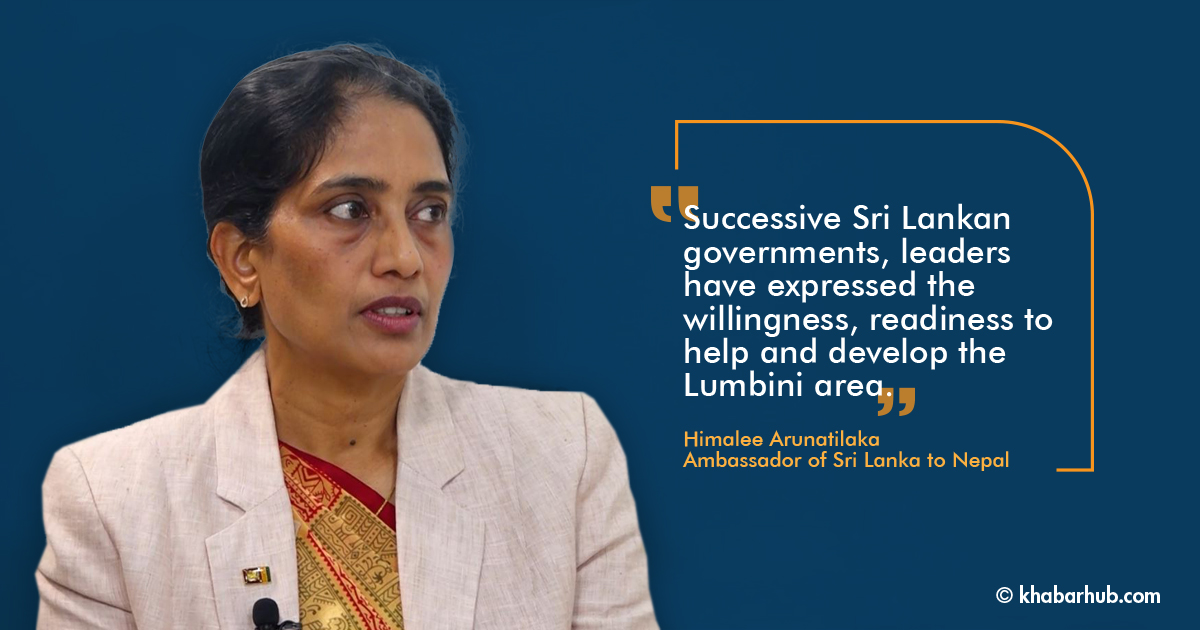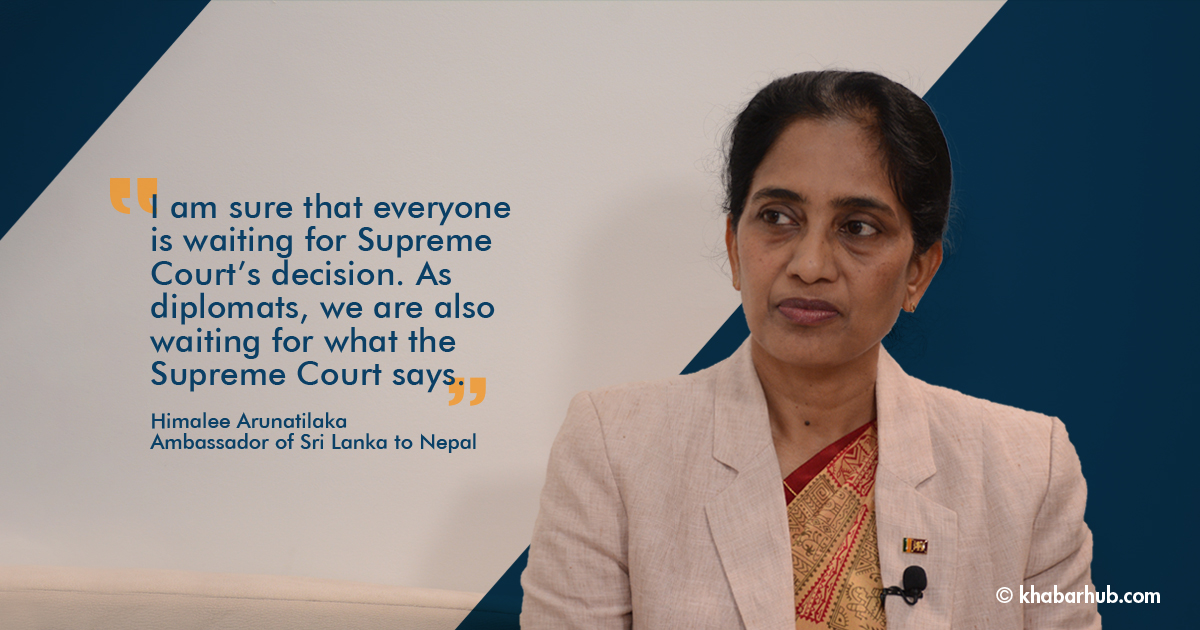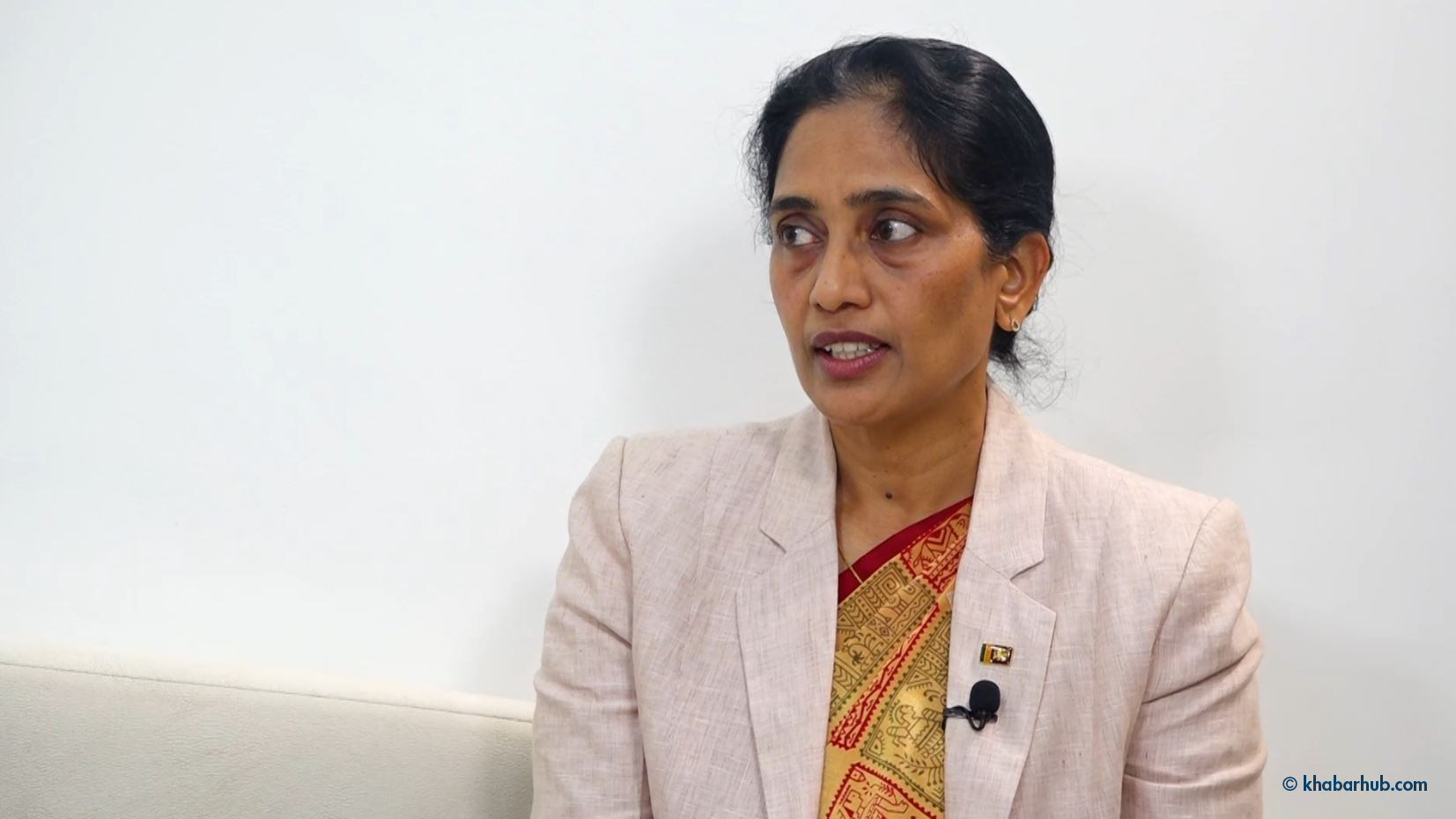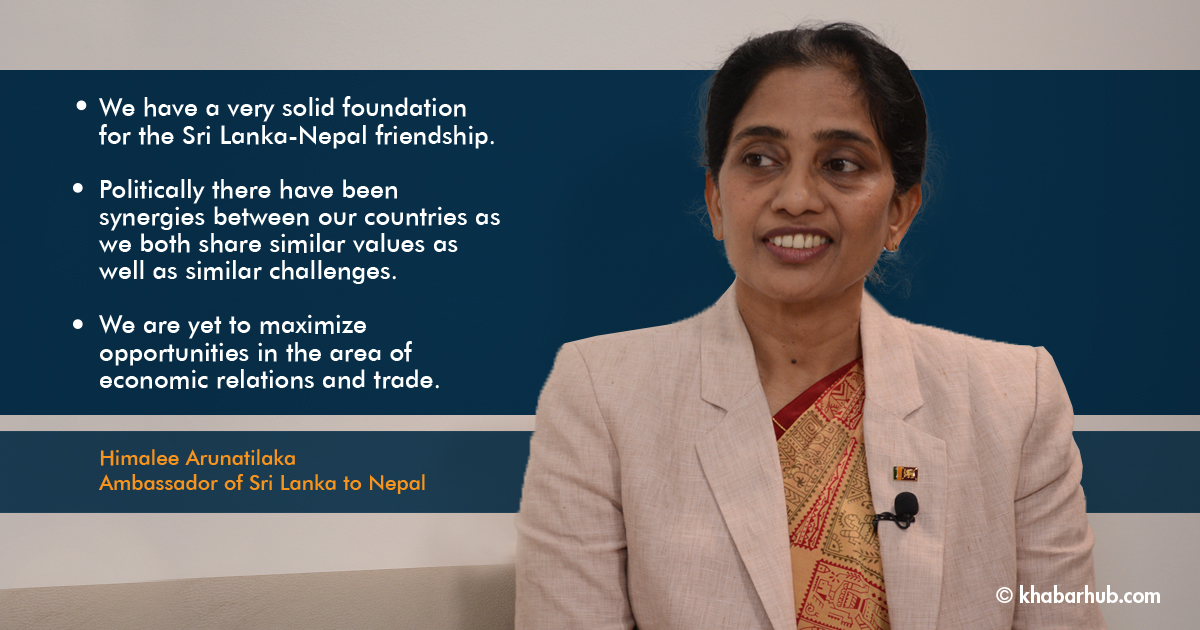Sri Lanka, the island nation, has maintained and expanded into a multifaceted historical relationship with Nepal since it established diplomatic relations with Nepal in July 1957.
The relationship between the two countries has been based on cultural and religious ties. Meanwhile, the people to people contacts between Nepal and Sri Lanka have existed for many centuries.
Nepal-Sri Lanka relations have been based on mutual understanding and friendship, and concrete efforts have been made to further consolidate the friendship to a higher level.
Ishwar Dev Khanal and Kabita Shrestha from Khabarhub talked with Himalee Arunatilaka, Sri Lanka’s Ambassador to Nepal on various issues ranging from bilateral relations, tourism, among others. Excerpts:
How do you find yourself to be in Nepal?
I consider it both a privilege and a blessing to be the Ambassador of Sri Lanka in Nepal. Given the special nature of the relationship between our two countries and also the longstanding Buddhist links, Nepal-Sri Lanka relationship has always been one of warm friendship and very close people to people links. So, as a Buddhist in particular, it is a pleasure and a blessing to be here.
You joined the Sri Lanka Foreign Service in 1998. Since then, you have served in various capacities in several countries. Where do you see yourself at the moment?
Well, as a career diplomat, one has to be ready to serve any part of the world, where ever the government sends us.
Similarly, back in the foreign ministry in Sri Lanka, a career diplomat has to be ready to serve in any part of the world, and each experience is different. You are also called upon to handle different subject areas while back home in the Foreign Ministry.
My previous experiences overseas have been always outside the South Asian region — to Europe and Australia. This is my first experience in our own region. It is an opportunity that I greatly value. I mention it as a privileged and special opportunity.
This is the first opportunity I got to serve in the region, and I greatly value that opportunity.
What differences did you find while working in Europe or Australia and to serve in this region, particularly in Nepal?
Well, first thing is that I find here in this region is cultural similarities. Most of the SAARC countries have a similar culture. Look at this country, Nepali people are very similar to the Sri Lankan people.
Nepali people are very hospitable, very warm. I feel very much at home here.

Talking about the Nepal-Sri Lanka relationship, it goes back to centuries. How do you envisage the future of these two friendly countries?
As you rightly said, this is a centuries-old friendship. So we have a very solid foundation for the Sri Lanka-Nepal friendship. Politically there have always been synergies between our countries as we both share similar values as well as similar challenges.
There a warmth, and friendship, and a very close bond between the peoples also.
One area I think we have not yet maximized the opportunities is in the area of economic relations and trade. This is where I see the future of our bilateral relationship.
Because economic relations are the bread and butter for any relationship, and the one area that can bring long-term and tangible results to the peoples of the two countries. So I think it is absolutely important for Sri Lanka and Nepal to build on our bilateral trade and economic relations.
And, in fact, the first contact is Buddhism. Buddhist links are very strong besides the cultural link. So, our friendship and cultural links come back from those times.
And, even in recent times, Sri Lankan monks have been playing a crucial role in the revival of Buddhism. We have very close cultural and Buddhist links.
Could you please particularize these relations?
Yes, as I said earlier, the relationship goes back to ancient times.
At present, Lumbini, very obviously, is the strong connection between the two countries where Prince Siddhartha was born. Buddhist links come from that.
Successive Sri Lankan governments and leaders have also expressed their willingness, readiness to help and develop the Lumbini area.
Sri Lanka’s Mahabihar in the monasteries zone is a visual symbol of our commitment towards Lumbini and the pilgrim site inside Lumbini. After the earthquake, we have undertaken to reconstruct two temples in the Kathmandu Valley.
The Anandakuti Bihar, which has a long history and links with Sri Lanka has been fully reconstructed and handed over in 2019 to Nepal.
And regarding the Rato Macchindranath, a heritage temple, the reconstruction work is continuing.
Sri Lanka became independent in 1948. Likewise, in Nepal, a new form of change has taken place politically. Since the beginning of 1957, there have been a lot of exchanges between the two countries. There have been various discussions leading to agreements being signed between the two countries.
Moreover, several initiatives have been taken to lead trade relations, economic relations, and educational links. Both the countries have tangible aspects of relationships.
As an Ambassador, do you have any special plan to increase the number of tourists in Nepal especially to Lumbini?
If you look at the numbers of tourists visiting Lumbini from Sri Lanka, we are among the top 5 in inbound tourists. In 2018, if I am not wrong, it was the highest number of around 70,000 tourists. I am talking about the pre-2020 period.
To be honest, I would like to say that the Sri Lanka tourists need to diversify to other areas as well. Nepal is very beautiful with many land discovered attraction sites that Sri Lankans should come and see.
During my interactions with the stakeholders of the tourism industry, I have mentioned to them that places such as Ramagram, and Kapilvastu should also be promoted.
When we talk about outbound tourism from Nepal to Sri Lanka, the number is less. On average, around 5,300 Nepalis visit Sri Lanka per year.

From the embassy site, we are looking for ways to promote Sri Lanka as a tourist destination. The numbers, however, have increased in recent years but in comparison to Sri Lankan tourists, it’s very low.
Even after COVID-19, I must say, Sri Lanka has opened for foreign tourists. There are clear health guidelines, published on the Sri Lanka Tourism website. Within those parameters, Sri Lanka is open for all and particularly for the Nepali people.
Being an island country, we have been offering a very unique experience with our cultural sites, Buddhist sites, and the Ramayan trail, among others, will, I am sure, particularly attract the Nepali people. We have wildlife as well as ocean life. Sri Lanka is the home of the largest mammals on earth like elephants as well as blue whales. In that sense also, we are very unique. I would encourage Nepali people to travel to Sri Lanka.
Despite a significant number of Sri Lankan tourists visiting Nepal, the air link between the two countries seems to be a little complicated. Do you have any plans to have a direct flight?
Yes, this is something we have been working on very vigorously and in late 2019, we had very positive news from Sri Lankan Airlines. Unfortunately, the plans were derailed by the COVID pandemic.
As you may know in 2016 Himalaya Airlines also flew to Colombo and they have shown interest to recommence flights. So I hope that one of the two airlines, or even both of them, might consider direct flights in the near future.
Having direct air connectivity will be a great promoter of more frequent visits between the two countries not only for tourists but also for business people and students. But I am confident that very soon we will overcome those challenges and I hope very soon we will have direct air links.
Do you have any concrete plans of exchange visits, increasing the number of tourists to Nepal in the near future?
There is a Joint Commission between Nepal and Sri Lanka, and we have been discussing with the Ministry of Foreign Affairs here to convene the Joint Commission, in Sri Lanka.
This is at the Foreign Minister level, so if the dates can be finalized, we hope to be able to welcome Nepal’s Foreign Minister Pradeep Gyawali to Sri Lanka very soon. This will provide a platform to discuss the whole spectrum of the bilateral relationship.
And as I said earlier, Sri Lankans are among the top 5 inbound visitors to Nepal. This should be diversified from pilgrims to other tourists also.
From the Embassy side, we hope to carry out more aggressive tourism promotion to attract more Nepali tourists to Sri Lanka as well.
We also hope to attract more Nepali students to choose Sri Lanka as a destination for their higher studies. They will have a unique experience, particularly given the close cultural links between our two countries, and also the high quality of education services that are available in Sri Lanka.
Proximity wise also there is an advantage while the cost is comparatively lower. We are on par with developed countries when it comes to education standards, and now there are many higher education institutions in Sri Lanka offering a range of fields of study to choose from. This is a sector we hope to increase exchanges in.
There are other sectors where Nepal and Sri Lanka can work together. How do you plan to work towards strengthening economic cooperation to take bilateral relations to the next level?
This is actually a priority area for the Embassy, to work towards better, more robust and active economic relations. This is where the future is for our bilateral relations.
We have been working closely with the Nepali private sector, notably the Nepal Sri Lanka Chamber of Commerce and Industry and other business Chambers, to improve trade between the two countries.
There are areas such as trade, education, tourism, and hydropower for potential collaboration. Can we expedite these sectors?
Trade has not been at a satisfactory level, although in recent years there have been some sight improvements. In the first six months of 2020 also, trade was about USD5 million, which was encouraging given the COVID pandemic, though there is much room for improvement.
Seafood, ceramics, light engineering and electronics and food preparations and FMCG are some of the products that have potential in Nepal. From the Nepal side, I think lentils have the potential to be marketed in Sri Lanka, as well as paper products, especially lokta paper.
Education services is another area that can be greatly developed. Sri Lanka offers quality higher education at an affordable price to Nepali students.
There is also a bilateral agreement to exempt visa fees for the students of the two countries, and that is to encourage more educational exchanges. Sri Lanka also offers 5 scholarships every year under the Presidential Scholarship scheme to Nepali students.

There are other private higher education institutions also that offer placement, while some offer tuition waivers. I encourage interested students to follow the Embassy digital platforms for information on such opportunities. Most of the Nepali students go for engineering, management and even agriculture.
Tourism, as I have already mentioned, is another area that has more potential and space to develop and diversify, both ways.
Moreover, youth can be a great promoter, ambassador of two countries. Around 100 Sri Lankans are studying medicine in Nepal. They carry back a lot of first-hand experiences living in Nepal, interacting with Nepali people, and the same for Nepali students studying in Sri Lanka.
Not only for the own advancement but also future relations for the two nations.
Likewise, we also signed an MoU in 2018 on youth engagement between the two countries.
We have cooperation in the defense areas. Security forces personals go for training in each other countries. So, there are many areas of bilateral cooperation.
SAARC has been stalled. How do you the future of this regional body?
Well, Sri Lanka is very committed to regional cooperation and to the SAARC process. This has been reiterated when President Gotabaya Rajapaksa was elected in 2019.
For the first time, in the new government that took office after the elections in August, there is now a State Ministry for Regional Cooperation under the Foreign Ministry’s portfolio.
However, SAARC can only be as strong as its members. There are also many initiatives within SAARC that are happening, on education, culture, etc. But because there is no political engagement and the summit has not been held, the widespread perception is that it is not moving at all.
So I think it is up to the member countries to move forward on areas where we can find commonalities and keep regional cooperation alive. The recent initiatives to cooperate on COVID assistance is a very good one, similarly, we can maybe work on developing intra-regional tourism and promoting the region for Buddhist tourism given our shared heritage.
Intra-regional trade is another area we can work on. SAFTA can be a good platform for the member countries, to develop intra-regional trade. This is particularly so given the pandemic situation which has economically affected all of us.
How do you analyzing Nepal’s current political situation?
I am sure that everyone is waiting for the Supreme Court’s decision. As a diplomat, we are also waiting for what the Supreme Court says.
How do you describe your country as a tourism destination, which once was battered by the civil war?
Sri Lanka has always attracted visitors to its shores, from ancient times, due to our location. So tourism and hospitality come naturally to us. Perhaps that is why we are so well known as a tourist destination.
Although the internal conflict and natural disasters like the 2004 tsunami, and the pandemic have had a devastating impact on the industry, it is also a very resilient industry that has always bounced back.
Sri Lanka has been named the best destination in 2019 by Lonely Planet. It has also attracted many other accolades from the international tourism industry.
Besides the warm hospitality of our people, and the natural and historical attractions we have to offer have made us renowned. We have 7 UNESCO heritage sites in Sri Lanka. The richness and diversity of the culture and the people are the best attractions.
We offer a lot of diversity within a small area which also makes us a unique destination. There many places of natural beauty, wildlife, ocean life, culture, food, etc.
In Sri Lanka you can also see the largest mammal on land – the elephant as well as in the sea – the blue whale. So it is a unique destination in many ways.
So I would encourage Nepali people to visit Sri Lanka and experience these many attractions.
Do you have anything to share with Nepali people?
I hope we will get a direct air link very soon. It will be easy for people, tourists, businessmen, students and others to travel between two countries. I would like to see the joint commission being held.
These two will be a tangible milestone. I would like to see more exchanges in sectors such as education, tourism and in terms of trade.
I would like to encourage Nepali people to travel to Sri Lanka as we have already reopened for foreign tourists.









Comment